Quick article navigation
Painting is perhaps the most correct and optimal solution for the walls of a children's room. Here are a few reasons why:
- Painted walls are not afraid of felt-tip pens and prints of dirty palms after eating. In most cases, all traces of vandalism can either be washed off (for example, with nail polish remover) or simply painted over with a new coat of paint of the same shade.
- Having painted the walls, you can forget about their repair until the child graduates from school, which cannot be said about the wallpaper, which over time begins to peel off and lose color.
- Wallpapers always have visible seams between the canvases, which somewhat spoil general form walls and, moreover, are a weak point - it is at the joints that the coating begins to peel off or be damaged. Painted walls do not have this problem and always look neat.
- Walls painted in one color will be the best background for all kinds of wall decor - posters, photographs, interior letters, etc.
- Having once well prepared the walls of the nursery for painting, in the future you can repaint them easily, quickly and as often as you want. For example, if you need to update the interior by age.
Of course, painting has its drawbacks:
- Before you paint the nursery, you need to level all the partitions and bring them to a perfectly smooth state, which is quite difficult and expensive. Sometimes the walls are so crooked that it is simply impossible to align them. In this case, it is better to apply paint on wallpaper for painting, which, due to its relief, makes the curvature of the walls less noticeable and, moreover, hides minor defects in the base.
- Painted walls, unlike wallpapered ones, do not have any patterns or patterns. However, if desired, they can be decorated with vinyl stickers or painted with acrylic paints.
From this material you will learn how to paint the walls in the nursery, choose the color and type of paint, and you can also get design ideas from a selection of photos of children's rooms.
What color to paint the children's room?
As you know, color sets the mood not only for the room, but also for the emotional state of your child. Therefore, when choosing colors for a nursery, in addition to its size and illumination, one should also take into account the character, age and gender of the owner of the room. Here are some ideas and tips to help you decide what color to paint your child's room:
- The age of the child must be taken into account.
- In the bedroom of a newborn, pastel and soothing shades are appropriate: cream, pale blue, powdery pink, light lilac, pale green. These delicate colors will not interfere with your baby's sleep.
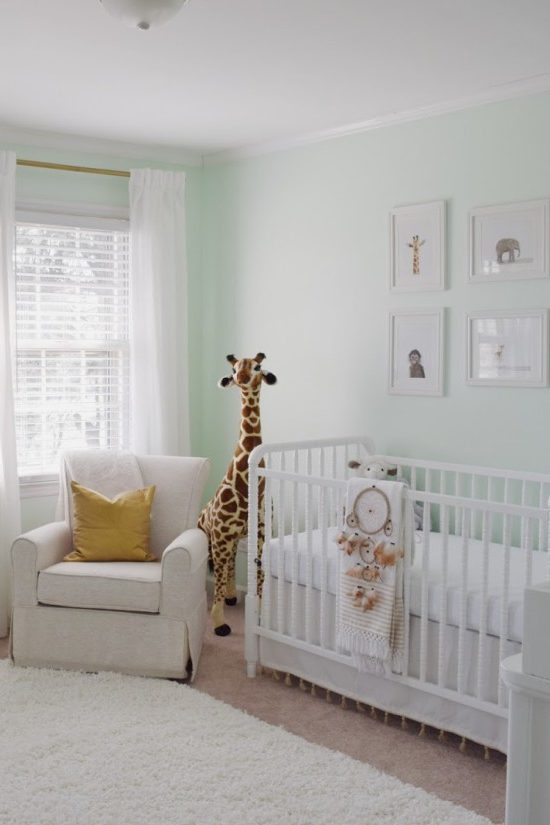
- For kids aged 2 to 7 years, you can choose more saturated colors - green, orange, yellow, pink, blue and even red.
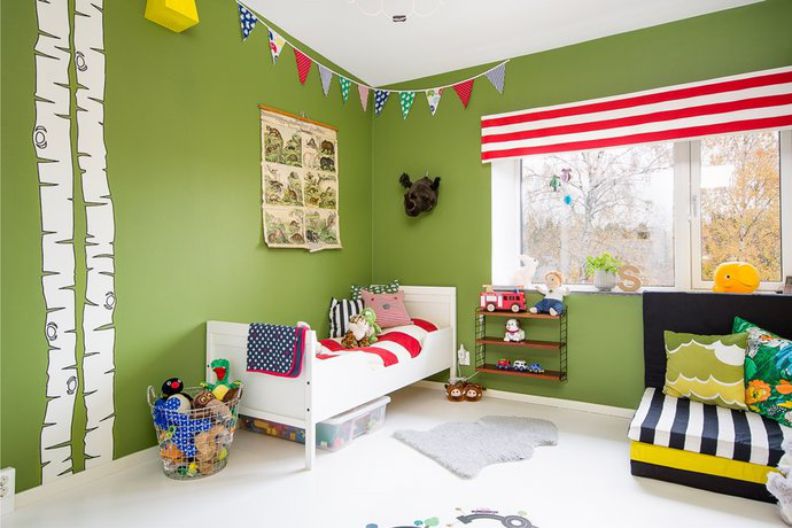
- But for children who have reached school age, calm shades of green, blue, blue or turquoise will help to focus on classes.
- The walls of the teenage room can be painted either in one of the neutral "adult" colors (light gray, gray-blue, olive, beige, brown, etc.), or choose bold bright or very dark shades. For example, it can be black and white walls with pink accents in a girl's room or orange accents in a boy's room (see photo).
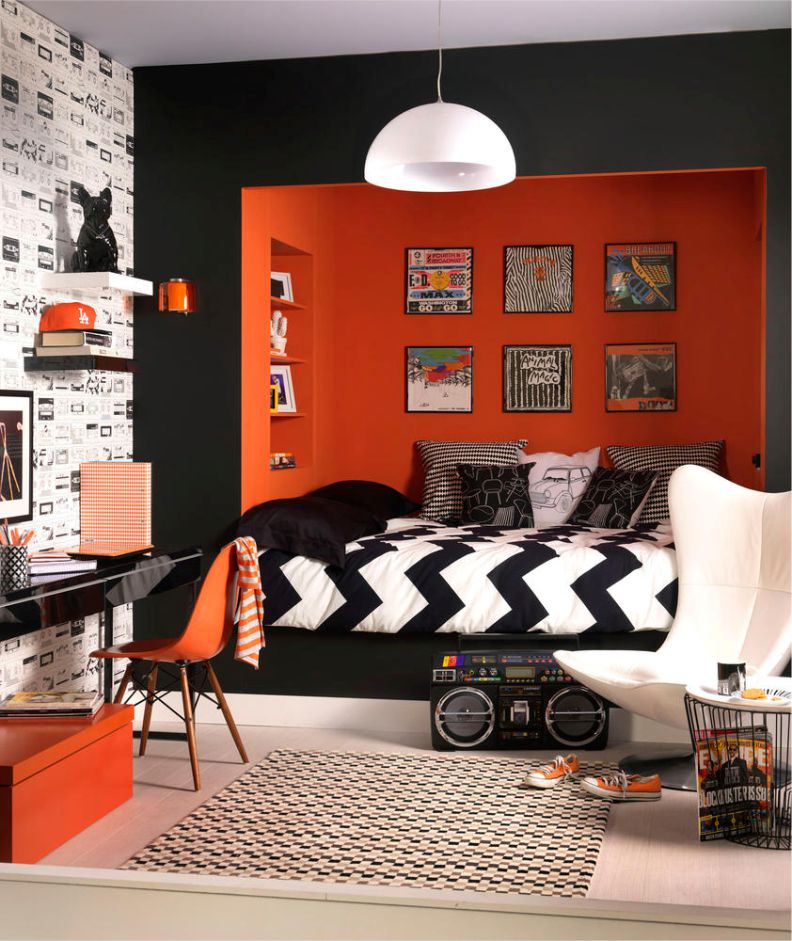
![]()
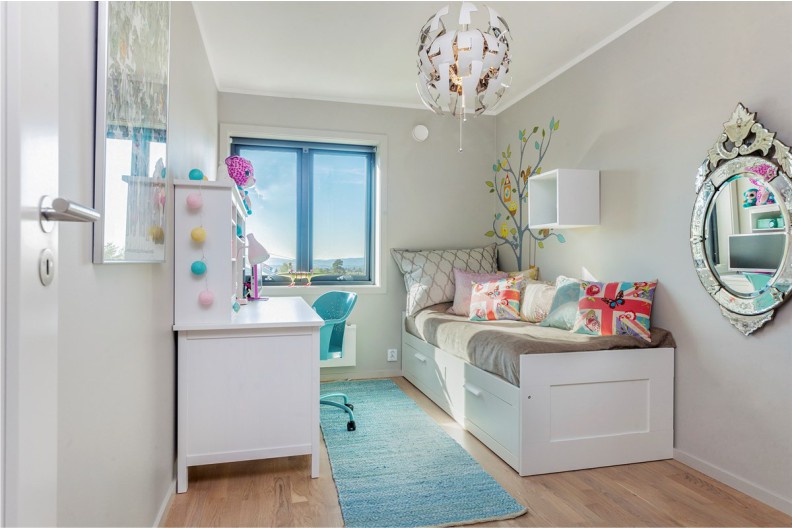
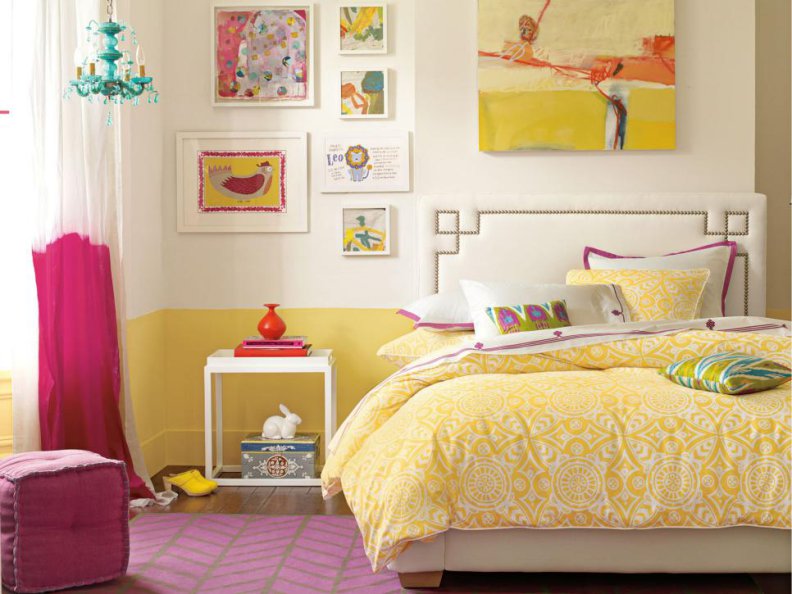
- At the same time, remember that some colors, even in diluted form, can greatly affect the activity and mood of the child. So, for example, even a pale shade of yellow on the walls will act as a tonic. Therefore, when choosing paint for a nursery, it is important to take into account the nature of the child. For active and mobile children, it is worth choosing soothing colors: green, beige, pink, blue, turquoise, blue, gray, brown, lilac, white. If the child lacks mobility, tone and sociability, then the walls of his bedroom can be painted with invigorating shades: yellow, red, orange.
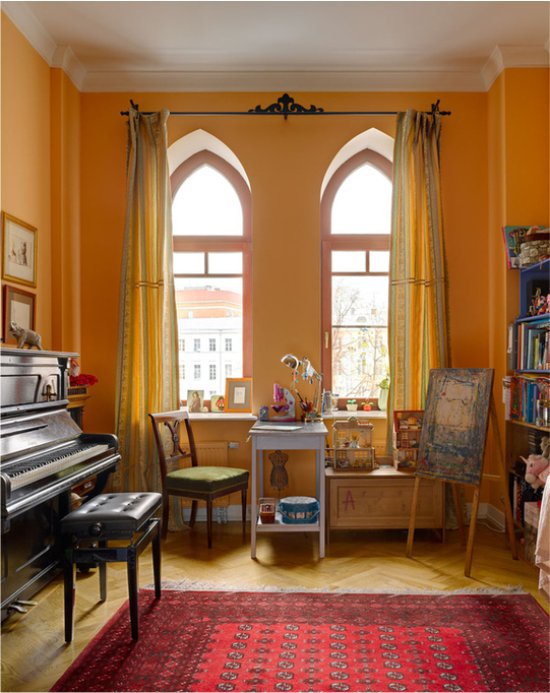
- Consider also the orientation of the room to the cardinal points and the degree of its illumination in the daytime. So, in sunny southern and southwestern rooms, walls of cold shades will harmoniously look: blue, gray-blue, turquoise, light gray. The walls of the northern bedroom with a lack of light are best decorated with warm and light colors: cream, beige, pale yellow, coral, pink or lilac. Both in the south and in the north room, soft white, light gray and green colors will look good.
- In order to visually expand small room use light shades. If the room is very small and dark, then it is most effective to use at all White color as in the interiors in the photo below.
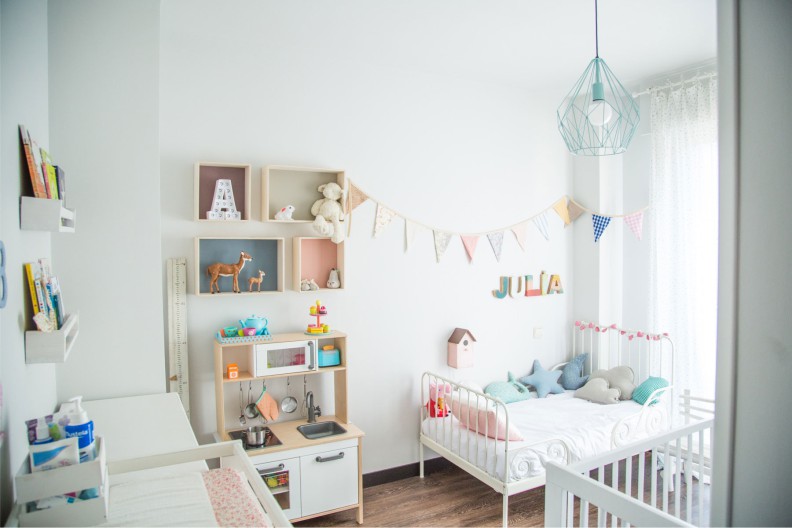
- If you want to decorate the interior of the nursery for growth, then we recommend painting the walls with neutral paint: white, light gray, beige, gray-blue, pale green.
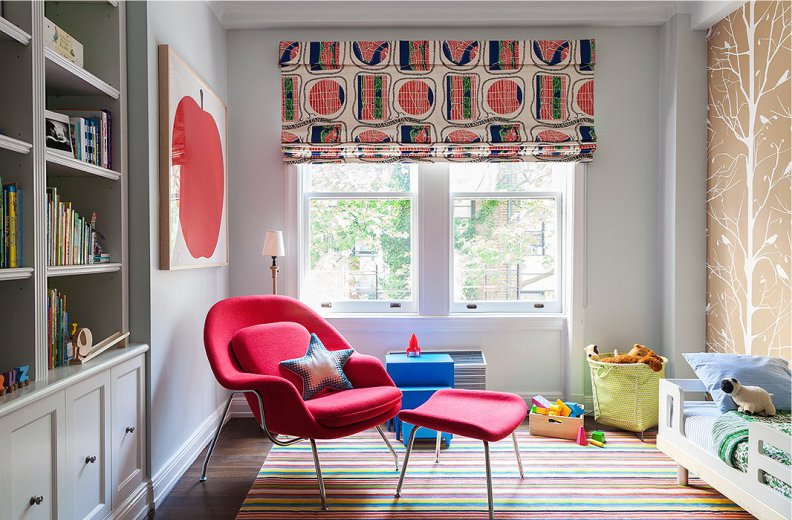
- It will be great if the owner of the room himself chooses what color to paint the children's room. In order not to worry about the impracticality or excessive boldness of his decision, you can come to a compromise by offering the child a choice from the palette that you yourself would approve.
See also the section of the site: Children's color.
How to make painted walls more interesting? 5 simple ideas
Plain painted walls are good on their own, but if desired, they can be decorated in a more original way. Here are a few ideas to keep in mind.
Idea 1: Painting with acrylic paints
Wall painting is especially relevant for a thematic interior of a nursery, for example, in a marine or fairy-tale style. Drawing can be both complex and detailed, and simple and uncomplicated. Large compositions are best placed on only one wall, while small prints can be distributed in several places in the room at once, for example, above the bed and in the play area. And one more piece of advice - if the room is small and there are enough bright objects in it, then large and bright drawings will only reduce the space and overload the interior. Other tips, decor ideas, and step by step instructions for painting walls with your own hands, read this article.
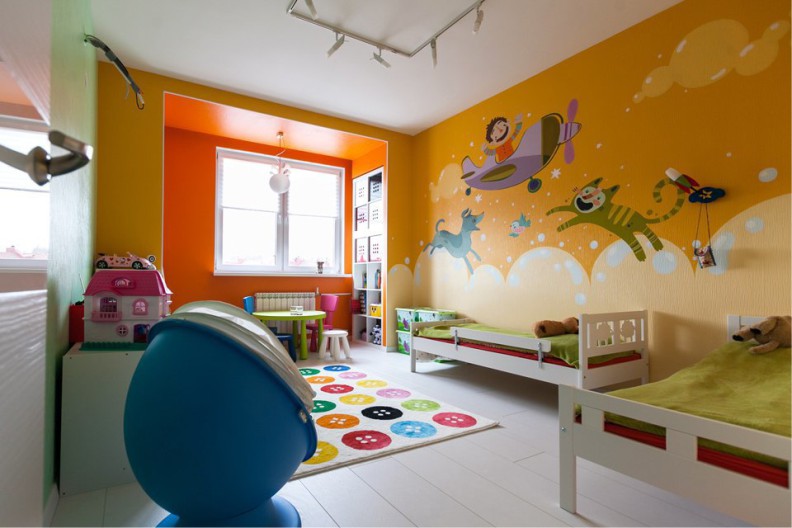
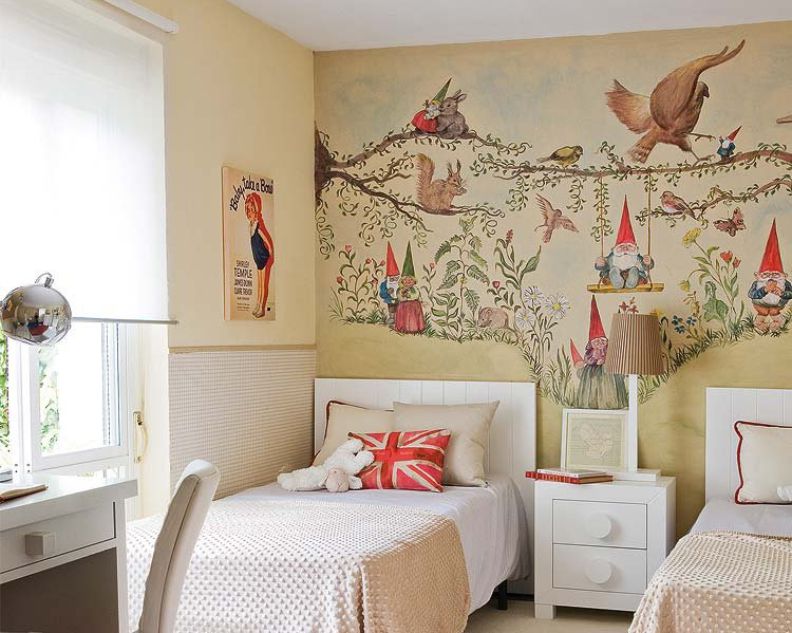
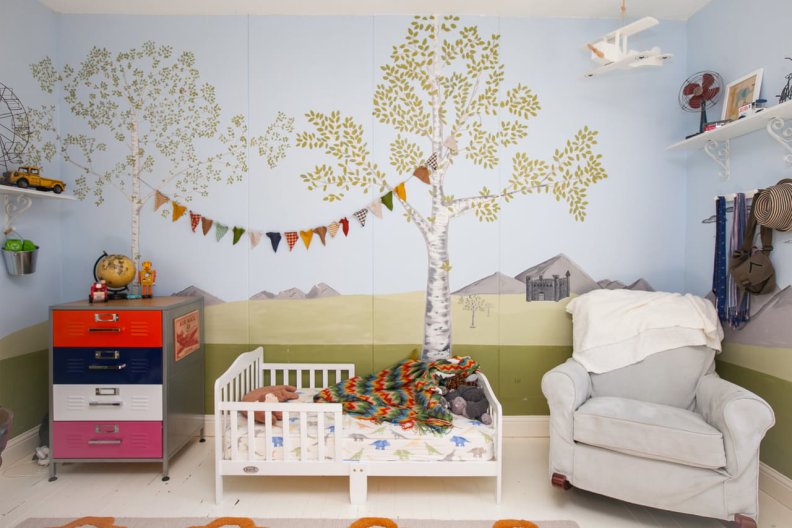

Idea 2. Highlighting the accent wall with color
If you want the child's room to be bright, but you are afraid to overdo it, paint only one wall or part of the wall with colored paint, and decorate all other partitions in a neutral way. So you make the interior stylish without overloading it. In addition, in this way, you can zone the space, visually separating, say, a sleeping or play area from a work area.
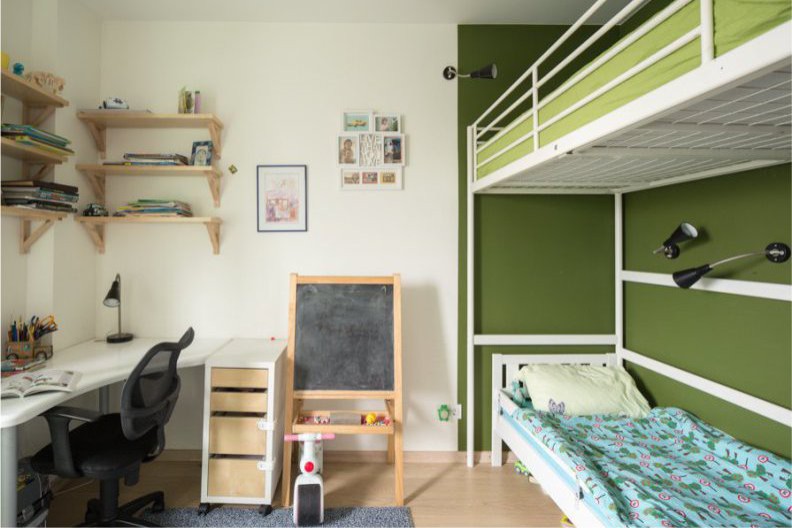
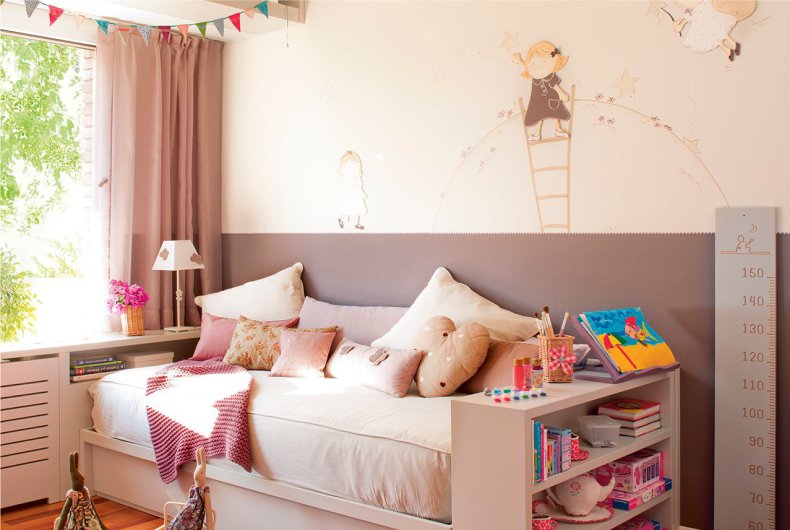
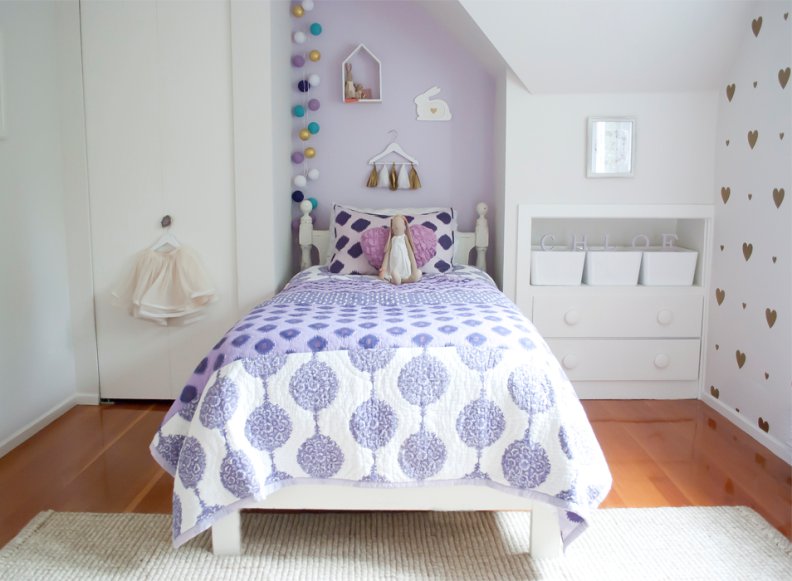
Idea 3. Creating an optical illusion
Idea 5. Combination of painted walls with wallpaper or photo wallpaper
Not sure which is better - paint the walls or wallpaper them? Or maybe both? By sticking beautiful and colorful wallpapers or photo wallpapers on one wall, and simply painting the rest of the walls, you will only benefit from a compromise - make the interior stylish and save on wallpaper.
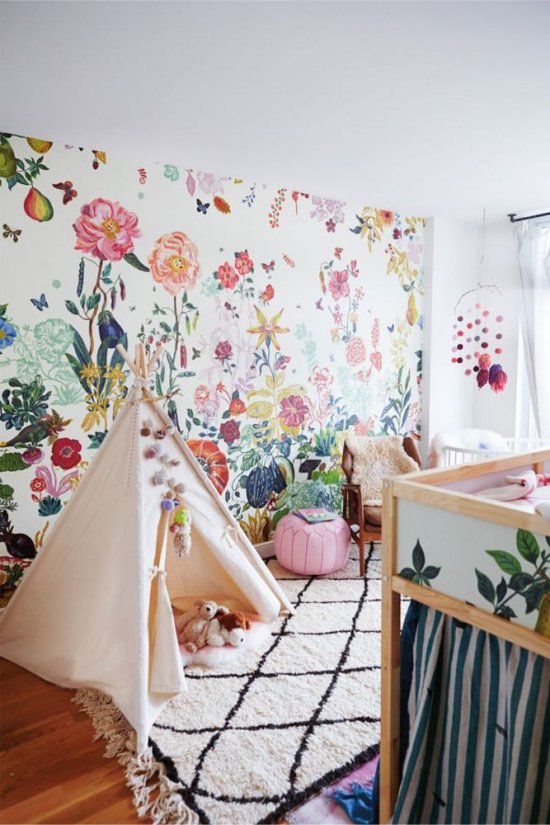
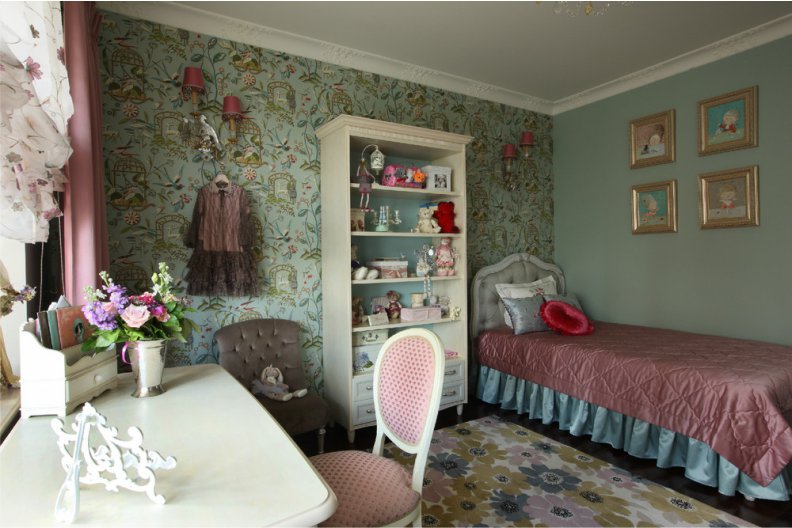

How can you paint the walls in the children's room?
The walls in the child's bedroom should be covered with paint, which is intended specifically for decorating children's rooms and has special characteristics:
- Water resistance;
- Hypoallergenic;
- breathability;
- Abrasion resistance;
- Thixotropy (for ease of application);
- Economy in price and consumption.
How can you decorate a nursery? Wall coverings that meet all of the above characteristics are sold in the following types:
- Water-dispersion paint or just water-based emulsion- dries quickly, breathable, does not smell, easy to clean and, moreover, inexpensive.
- acrylic paint- it has characteristics similar to water-dispersion paint, and in addition to all the pluses, when dried, the paint forms a high-strength matte surface.
- silicone paint- This cutting edge material for painting walls, which has both vapor permeability and water resistance at the same time.
- latex paint- Fits well and stays strong. The surface painted with this paint is very pleasant to the touch.
- Ecological paints- paints with the most natural composition, even from their name it is clear that they are the best suited for a nursery. Their only downside is the cost.
Most easy way choose the perfect option - find paint labeled "Kids" or "Children's Room".
And what paints can not paint the walls in the nursery? Oil and alkyd enamel paints are categorically not suitable for children's rooms because of the pungent smell and "non-breathing" surface.
5 average rating: 5,00 out of 5)
Rooms play a huge role. Incorrectly chosen colors and even shades can adversely affect the child's nervous system, turning a calm baby into a crybaby, and an excellent student into a restless and distracted three-year-old.
The room in which the child spends a significant amount of time should change with him: the baby needs one thing, the elementary school student needs another, the teenager needs a third, and wall color in nursery should reflect these needs.
best color for nursery the room in which the baby lives - blue, pink, green, peach and their shades, always light, pastel colors, as if "diluted" with milk. They will soothe, create a feeling of security and comfort. Dark shades are undesirable, they have a depressing effect on the human psyche.
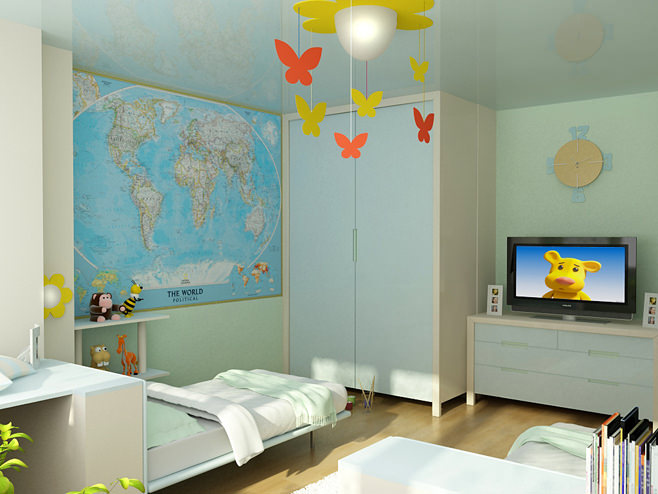
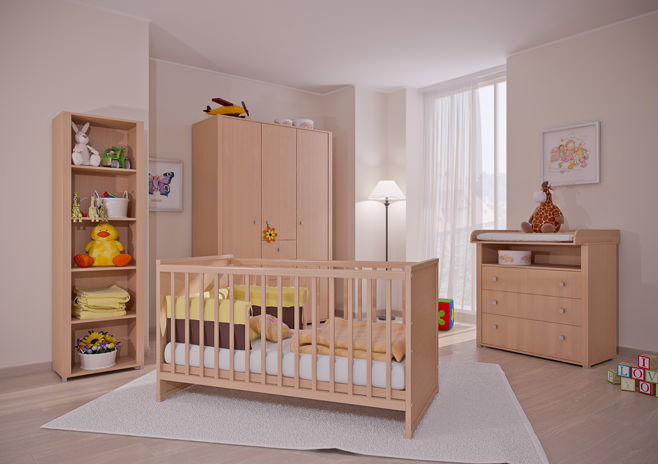
The child grows - changes and preferred wall color in kids room. You can gradually add brighter colors, shades, use drawings, including templates. A very interesting design option is the use of large drawings, abstract or geometric, against the background of plain walls. Children's drawings can also be a wonderful color accent.
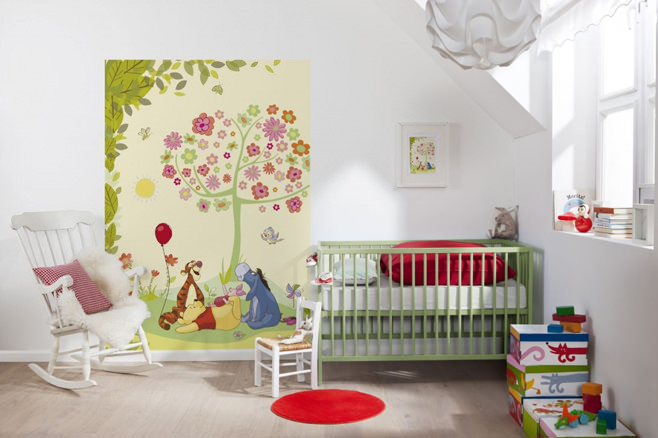
Palette
Violet color in the interior of the nursery helps to concentrate, awakens the creative abilities of the child, stimulates the thirst for knowledge. Perfect for both toddlers who are starting to get acquainted with the outside world, and for schoolchildren - from first graders to graduates. How older child- the juicier, the richer the shade of color can be.
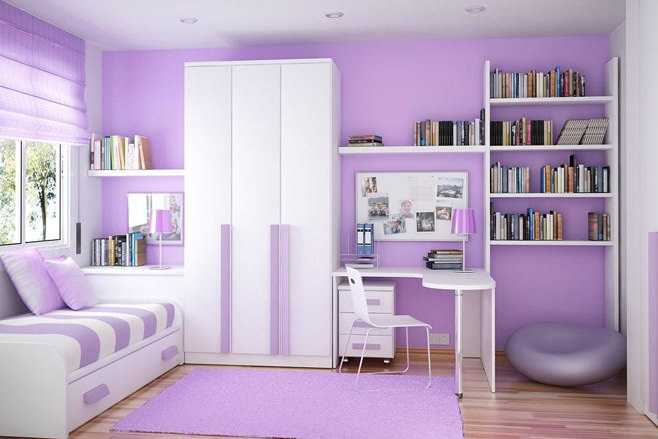
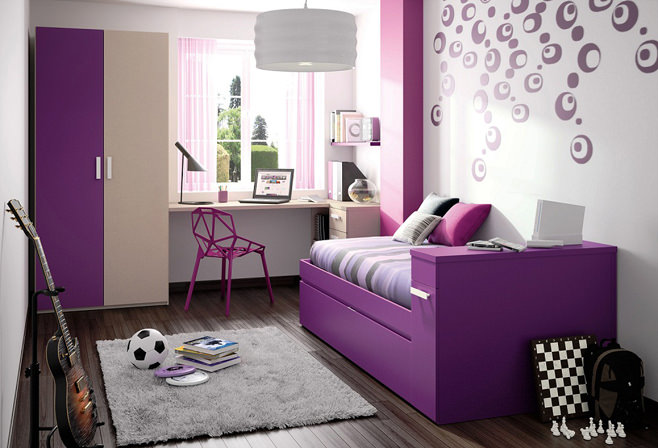
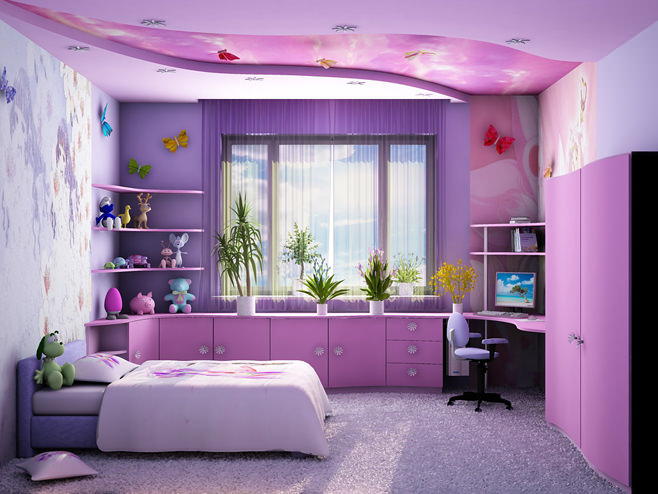
Blue and its shades as the main wall color in nursery room promotes health, stabilizes the nervous system. It is important that it is not too dark, deep blue, especially in a room for babies.
You can add similar colors of the spectrum - sand, peach, yellow, green. Such combinations will work to increase curiosity, and at the same time will not give overexcitation. Psychologists especially recommend blue tones for hyperexcitable children, as well as for owners of a sanguine temperament.
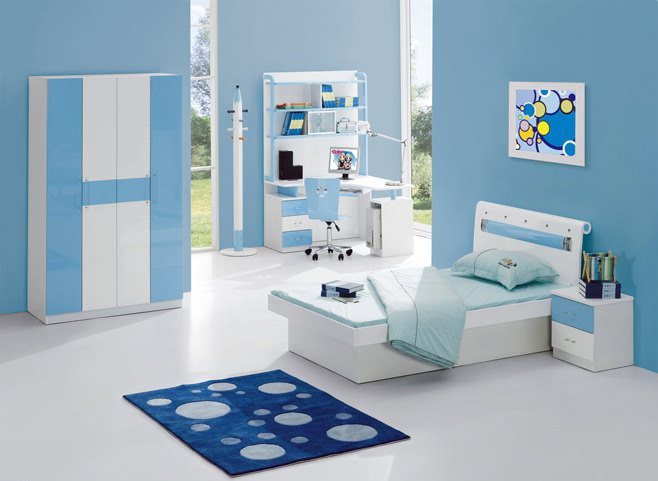
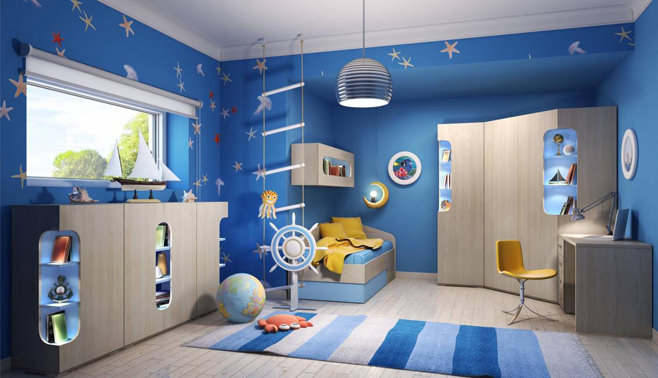
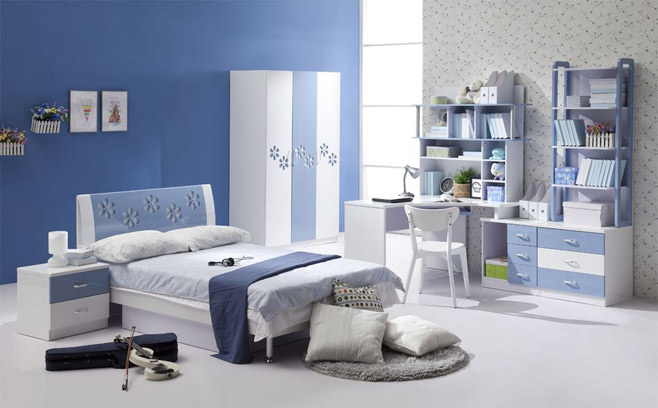
Green as the main color in the interior of the nursery room has a beneficial effect on health, increases visual acuity, normalizes the pulse, promotes a good mood and sound sleep. Perhaps it can be considered best color for baby, especially if you play with hues and saturation. For example, make the walls light green, and the decor elements bright emerald.
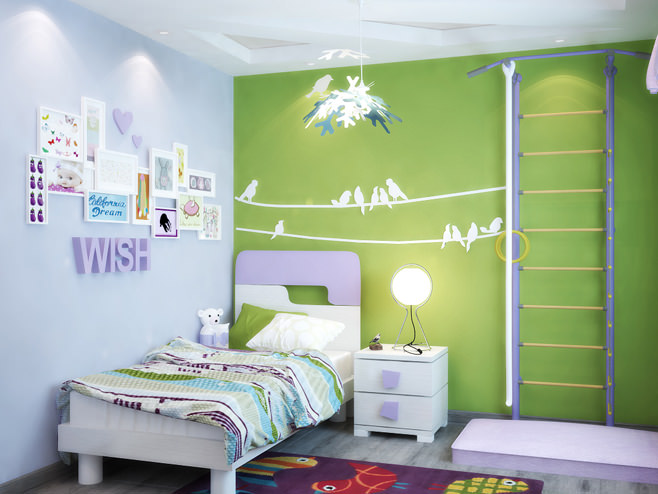
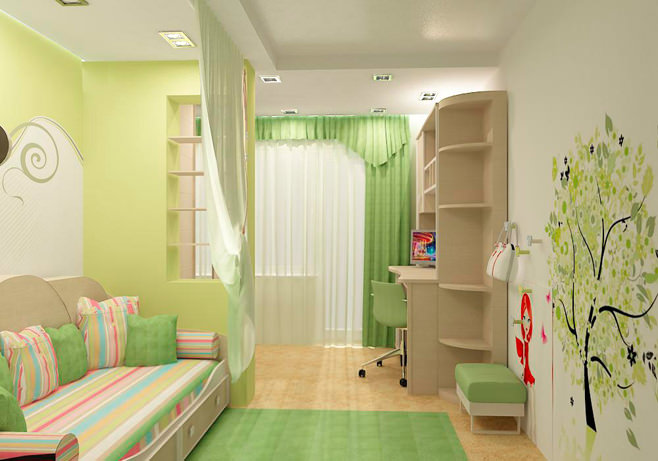
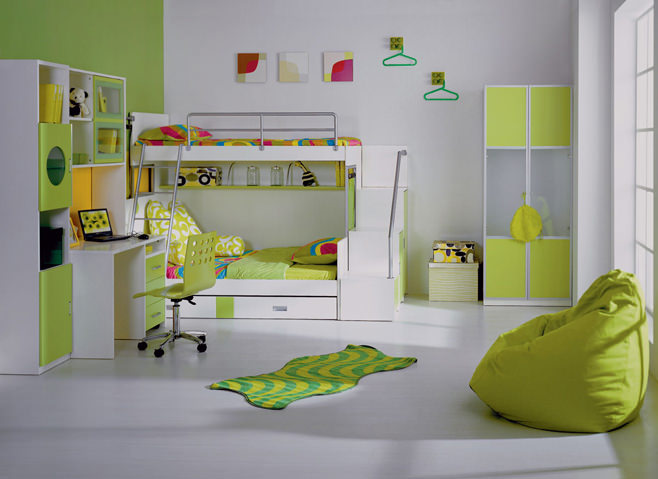
Yellow, orange and red colors for decorating a room where a child is located are generally undesirable. They contribute to the excitation of the nervous system and are more often used in the form of color accents. In small amounts, this part of the spectrum increases appetite, stimulates metabolism and the process of digestion, in excess it can lead to overexcitation, headaches, anxiety, and insomnia.
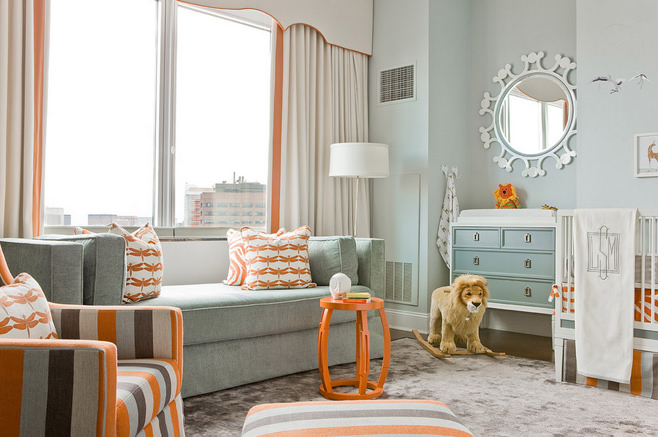
Rooms are also a game, fun and joyful. Combine different colors, experiment with shades, but avoid too harsh and contrasting combinations: this can cause irritation and negative emotions.
It has long been known that color affects the emotional state of a person. Interior designers have always actively used this feature of color in their practice. In the design of a children's room, it is recommended to use light, pastel shades, although here it is necessary to take into account the temperament of the child.
Calm children can be made more active with the help of bright colors and expressive patterns, the interior of the room of a mobile, emotional child should be designed in a range of two or three soft colors.
Coloristic decision based on the psychological meaning of color
Each color carries individual information that can affect a person's condition. To decide on the choice of colors for decorating a children's room, you need to familiarize yourself with their meanings.
A children's room is a place where a child spends a lot of time. Therefore, when choosing a color and pattern for walls, curtains and the shape of other objects that fill it, one must strive to ensure that everything is beautiful, pleasing to the eye, and also contributes to the emotional and psychological development of the child.
At first, the child responds better to bright, saturated colors, large geometric shapes. This is understandable, because they attract attention first of all. However, there is an opinion that if a child is a gentle creature, then he should be surrounded by objects only in pastel colors - light pink, light blue, etc. We believe that we must adhere to the golden mean and not go to extremes. You should not completely exclude any colors from the interior. Depending on which zone in the room is made out, you need to give preference to one or another color.
You can notice what colors your baby likes very early. Even quite Small child already feels attachment to clothes of certain shades, chooses pencils and paints of a certain color from the box. If you give him a few multi-colored toys, he will immediately reach for the toy of his favorite color.
To more accurately determine what color the child likes, you can conduct such a test. To do this, you need to cut out several squares from multi-colored cardboard, lay them out in front of the child and invite him to choose any of them. So repeat several times. The square selected by the child repeatedly will indicate his favorite color. Love for a particular color determines the psycho-emotional state of the child, and indeed of any adult. The color also has many shades. And each shade has a psychological meaning. It can be positive or negative (table).
The psychological meaning of colors
| Color | Negative meaning | Positive value |
| White | Cold, emptiness, silence, otherworldliness, neutrality | Day, light, goodness, purity, spirituality, dedication |
| Black | Depression, pessimism, detachment, evil, witchcraft, darkness, uncertainty | Mystery, complexity, elegance, fertility |
| Grey | distrust, neutrality, uncertainty, protection | Balance between black and white, practicality, modesty |
| Blue | Sadness, mysticism, melancholy | Eternity, truth, masculinity, infinity, globality, sustainability |
| Violet | Complexity | Regality, elegance, sensitivity, spirituality |
| green, cold | Longing, immaturity | - |
| Green warm | - | Hope, growth, development, life, nature, spirituality |
| Yellow | - | Sun, greatness, power, intelligence, vigor, optimism, ease |
| Orange | - | Dynamism, power, greatness, life, energy, cheerfulness |
| Red | - | Strength, energy, passion, dynamism, determination, perseverance, aggressiveness |
| Pink | - | Love, kindness, life, warmth, tenderness |
| Purple | - | Power, greatness, spirituality, wisdom |
It can be seen from the table that after the transition of the warm “color equator”, negative color values disappear. It is normal for a child to strive for light, joyful, so he chooses bright colors, warm shades. But cold shades can also be juicy, sonorous, they can also be used around a child.
But if you notice that he is attracted to muted, indefinite colors, then this is a sign of internal psycho-emotional discomfort. This state of the child can be corrected by using the appropriate shades when choosing the environment and objects surrounding him. This method is called color therapy. And it will definitely give a positive result. The optimistic color environment of the child will create a joyful, positive psycho-emotional state in him.
Thus, curtains, wallpapers, and other items in the children's room perform not only an aesthetic or utilitarian function, but also form the psycho-emotional state of the child.
Consider the impact of each color on the mental state of a person
Red color
Relieves depression, stimulates the brain, it is associated with communication, love, high activity. But it should be remembered that the dominance of red in the interior can lead to increased fatigue. When decorating a children's room, you can use shades of red.
Orange color
It creates a feeling of well-being and joy, helps to get rid of obsessive fears. Orange combined with white gives a feeling of sunlight, so if the room is poorly lit during the day, feel free to choose this tandem.
Yellow
Increases brain activity, awakens curiosity, cheers up. But remember that the yellow color should not occupy the entire space of the room, as it can be exciting.
Green color
It has a calming effect on the nervous system and vision, relieves irritability and fatigue. Green goes well with light colors.
Blue
Relaxes, relieves pain, helps to cope with anxiety. But be careful: if you decorate the whole room in blue and blue, the child will feel tired.
Blue color
Sets in a calm mood, relaxes the muscles, helps if the child suffers from nervous and physical fatigue, insomnia.
It is also considered the color of creative inspiration. Shades of blue are associated with peace, so it is often used to decorate relaxation and sleeping areas. But at the same time, saturated blue can oppress the child, and make the room gloomy and cold.
Purple
Ambiguous, usually it is not recommended to use it in the interior design of a children's room, it causes apathy and depression. Nevertheless, it strengthens the immune system, sharpens the worldview, vision, can also relieve nervous tension, eliminate eye pain and fatigue. If you decide to use this color, choose the lightest possible shades.
Pink color
The effect of pink can be compared to the effect of blue. This color is good because it eliminates stress, normalizes the functioning of the child's nervous system, and has a strong calming effect. As a rule, the boys' bed is decorated in white and blue, and the girls' crib is white and pink.
White color
Neutral, when decorating the interior, it is often used as a background. From the point of view of psychology, white is also characterized as the color of harmony, capable of neutralizing the negative.
It is important to remember that bright colors only work positively if they are present in the details. In general, the child's room should be made in pastel colors, and brightness and emotionality can be given to it with the help of toys and colorful accessories. When choosing a gamma, you can be guided by two main methods of interior color design.
The first technique is based on a combination of muted colors similar in tone. The main surfaces are light, while the furniture is a little darker.
The second method is based on the possibility harmonious combination various contrasting colors. Make sure that the selected gamma creates a feeling of warmth and comfort in the child.
Speaking of color in the interior, we mean the color of the visible surface of things and materials. Interestingly, the texture - a feature of the processing and reflective ability of the surface - affects our perception of color.
Usually there are three types of textures: matte, glossy and shiny. Let's consider them in more detail.
The matte surface is rough, it scatters light in different directions, so it seems equally bright and evenly lit regardless of the angle of view. Plaster, brick and wooden surfaces, as well as paper wallpapers, fabrics, etc. have a matte texture.
The glossy surface is not capable of reflecting objects, while it has weak glare. This texture has a surface covered with oil paint or varnish, linoleum. In addition, it has a special silky sheen, which is inherent in plastic, glossy paper, etc.
A shiny surface is characterized by a special smoothness, it has such a feature: from one point of view it is bright, from the other it is dark, capable of reflecting objects that are around. This is the texture of a mirror, polished stone or metal.
If the room is dominated by objects that have a shiny texture (for example, varnished parquet, polished furniture, etc.), then, on the one hand, the space visually expands, but on the other hand, there is a feeling of anxiety, in addition, the color is distorted. Therefore, you need to be careful when using this technique in the design of a children's room. Even pediatricians recommend that there be less polished metal, glass, and mirrors in the children's room. And this is not only for safety reasons: the presence of a mirror in the nursery can lead to disruption of the child’s sleep. Psychologists recommend painting the walls of the room only with matte paint. It creates a favorable environment, does not tire the eyesight, and gives the impression of spatial completeness.
Color and texture are of great importance in the design of the interior of a children's room. We offer several color schemes for the nursery according to the styles of the children's room.
Bright herbariums, an aquarium with colorful fish, houseplants- all this looks great on a white background of furniture, walls in the room of a young naturalist. You can use green, light brown colors of the walls when light furniture, bright orange or yellow details.
For the room of a child who is keen on sports, you need to correctly choose a combination of contrasting colors. Usually for such interiors, combinations of white, blue and shades of red are used. Everything should breathe optimism, life-affirming energy.
The room of the young artist can be solved in light gray, blue-gray and white colors. Against their background, the fruits of children's creativity will look especially attractive. Furniture can be beige, green or light purple
The color scheme of the future traveler's room is as follows: blue in combination with beige, brown and white. It should be light, without pronounced contrasts both in color and in the pattern of wallpaper and fabrics.
Such a pattern has been noticed: with age, the color preferences of children can change. If up to 8 years old they prefer bright, expressive and even contrasting colors, then by 9-11 years old they begin to prefer yellow, shades of green, orange. And even later, after 12 years, children are usually attracted to blue.
How to take into account the orientation of the room on the sides of the color?
When decorating the interior, choosing the color spectrum, it is necessary to take into account the orientation of the room to the cardinal points. If the windows of the room face north or northwest, then warm colors should prevail in the setting.
Even if you choose a different color solution, remember that discordant combinations (such as yellow and purple, black and white, etc.) should be avoided in the interior, as well as dark, heavy shades that are tiring and destructive to the child's psyche.
Of course, it is impossible to take everything into account, so we have only outlined general rules and positions. When choosing the color of the future interior, first of all, consider the color preferences of your child, his temperament and worldview.
Many parents, when choosing a color for a children's room, do not even think about the fact that certain colors play a huge role in the lives of children. The child is affected not only kids room wall color, But furniture color, even toy color which he is constantly looking at. It depends on what colors will prevail in the children's room. What colors should be chosen for decoration children's room And when choosing toys for a child?
Currently, there is a whole science dedicated to the influence of colors on human health and development - color psychology. So let's talk about how certain colors affect the development of our children.
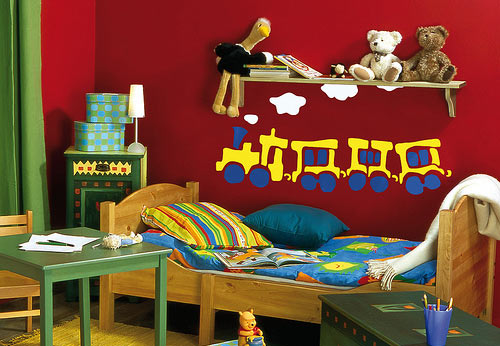 In the photo: red color for the children's room
In the photo: red color for the children's room Red is activity. A child whose room has red elements in the design becomes more active. Adding red elements to the design of a children's room is ideal for inactive children and undesirable for hyperactive children. But, it is important to consider that there should not be too much red, because red can develop cruelty in a child. When choosing the color of the walls, keep in mind that in a bright red bedroom.
Children's room in yellow
Yellow color has a positive effect on the mental abilities of the child. If you want to raise a smart, focused child, then you need to decorate the nursery in yellow. This color stimulates in children the desire to learn and assimilate information. In addition, yellow promotes self-confidence and the development of intuition.
Children's room in orange
Orange is the color of understanding and joy. If you need to have complete harmony in your relationship with your child, then choose orange for the nursery. Orange also reduces the feeling of loneliness when the child is left alone in the nursery. This color stimulates the appetite, which is very good for children who do not eat well.
Children's room in blue
Blue color calms, reduces activity. Adding blue to a child's room will make the child more relaxed. This color develops the child's imagination and the desire to learn new things. However, blue must be used in small amounts, otherwise it can cause serious depression.
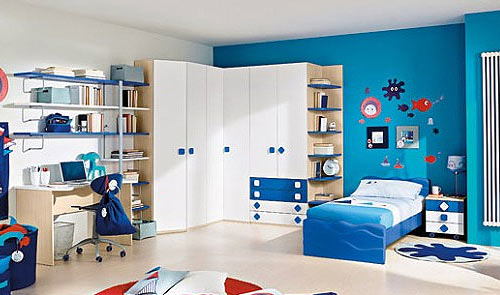 In the photo: shades of blue color in the children's room
In the photo: shades of blue color in the children's room Children's room in blue
Blue is the color of dreams and carelessness. He, like blue, soothes, but looking at the blue color, it is impossible to concentrate. Blue color does not contribute to the development of the imagination. Too blue children's room slows down the growth and development of the child.
Children's room in purple
Purple is the color of magic, magic and sensuality. If blue represents only dreams, then purple is a complete escape from reality.
Interestingly, women during pregnancy often begin to prefer purple. This is due to major changes in their lives. Escape from reality, immersion in dreams, expectation of miracles - all this is normal for pregnant women. But be careful, purple is not recommended for decorating a child's room. It does not allow the abilities of not only a child, but even an adult to be realized.
In addition, studies have shown that the prevalence of purple in the children's room can cause a child to become interested in same-sex relationships in later life.
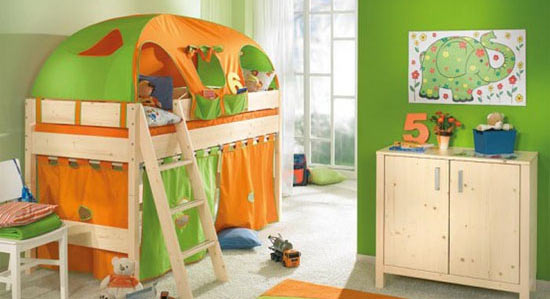 In the photo: green children's room
In the photo: green children's room Green color helps to dispel negative emotions of the child. IN green children's room children sleep well. This color has a beneficial effect on claustrophobic children. However, the predominance of green in the children's room can develop selfishness in the child. Being constantly in a too green interior, the child will feel sick for no apparent reason - this refers to the classic green color (with a bluish tint).
When choosing green as a wall color for a child's room, opt for a joyful yellow-green hue that makes a child want to learn and explore the unknown.
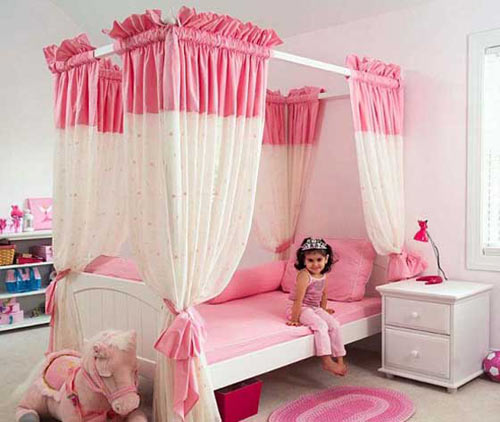 In the photo: the girl's room in pink
In the photo: the girl's room in pink Pink color (delicate shade of red) develops sensitivity in children, reduces aggressiveness. It calms, improves mood, causes a feeling of coziness and comfort. Child living in pink children's room, usually friendly, sensitive, calm, rarely, does not accept violence and cruelty. The softer the shade, the more beneficial the pink color affects the child. In the interior of the children's room, pink is well combined with white.
Too much pink in the interior of the children's room develops frivolity in the child, the desire to please no matter what. Such a child often overestimates his strength and cannot fulfill everything that he promises.
Blue for boys, pink for girls
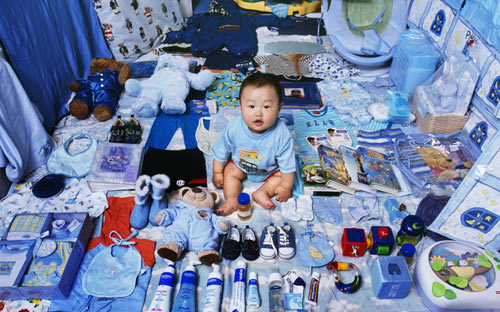 In the photo: too much with one color can be harmful to the child
In the photo: too much with one color can be harmful to the child Some parents find blue for boys and pink for girls ideal. However, it is impossible to categorically separate these colors by gender. Both colors have many shades. Blue can be successfully used in a girl's children's room, just like pink - for a boy's children's room. By the way, if a boy grows too active and aggressive, then the pink color will affect him faster than any persuasion of his parents. But this color should not be too much, because any color in excess has a negative effect on the development of the child.
What color to choose for a children's room?
 In the photo: light walls and bright colors of toys in the children's room
In the photo: light walls and bright colors of toys in the children's room When decorating a child's room, it is best to combine different colors. Use different shades of the primary color: the brighter and more saturated the color, the stronger its effect on the child. For walls, choose light shades, for furniture and toys - juicy and bright. When choosing, consider how long the child will have to look at this color. The ideal option is to delimit the children's room into zones with certain colors. Then you can be sure that the child will grow up healthy both physically and emotionally.
Psychologists say that human thinking is directly related to the development of visual perception: the finer this perception, the more shades the human eye distinguishes, the more perfect the human brain.
Psychologists advise to surround a baby of the first two years of life only with soft, desaturated colors; when he grows up, the nursery, on the contrary, may well become the brightest, most colorful and cheerful room in the house.
The baby's room should be soft and cozy, in calm, restrained colors. For example, it can be a combination of warm shades of blue combined with pastel yellow, which create a feeling of security and comfort. Cheerful and cheerful can make a room children's furniture painted in similar color combinations. In such an environment, the baby will be able to fully play, learn and relax.
Psychologists believe that starting from the fourth year of life, the baby begins to give preference to contrasting and cheerful colors - pure yellow, red, blue. At this time, it is very important to use pure colors in the design of the nursery, as such colors create a sunny and mobile atmosphere in the children's bedroom and playroom.
Dark shades of spectral colors are undesirable for decorating a nursery, because the closer to black a shade of any color is, the more depressing effect it has on a person. Light shades, on the contrary, evoke positive emotions, correspond to development, youth, strength. Scientists have found that a good, high spirits can be created using the color of ivory - light with a golden hue, and the pale blue color of the walls normalizes blood pressure and improves general condition.
Interesting solution- two-tone walls. For example, a combination of light yellow and light blue, but not monochromatic, but with small spots-blotches of a different shade of the same color: this “breaks” the monotony of color and gives the wall a picturesque look that is pleasing to the eye.
It is very important to choose the right shade of color. Often, for a girl's room, parents choose warm colors, in pinkish tones, for a boy's room - more "cool" color combinations, shades of blue. However, experts do not consider these color preferences a mandatory rule. They only recommend taking into account the impact of colors and shades on the emotional, psychological, and sometimes physical state of a person, which has already been mentioned earlier. 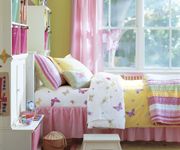 Psychologists recommend solving the interior of a children's room in gentle and pure colors: pinkish, greenish-yellowish, light blue, light green. Pastel colors in the nursery create harmony, they even help dark room make it more fun and cozier, create a lively atmosphere in it, very different from the measured "adult" premises. You can make a nursery interesting and comfortable using a small number of shades - for example, in beige and light lilac tones with the addition of brown.
Psychologists recommend solving the interior of a children's room in gentle and pure colors: pinkish, greenish-yellowish, light blue, light green. Pastel colors in the nursery create harmony, they even help dark room make it more fun and cozier, create a lively atmosphere in it, very different from the measured "adult" premises. You can make a nursery interesting and comfortable using a small number of shades - for example, in beige and light lilac tones with the addition of brown.
Some experts argue that a very light shade of purple is well suited for a schoolchild's room, as it gives a positive creative impulse and stimulates mental activity. Pastel colors are especially preferred for newborns and infants. Delicate shades of pink, for example, reduce excitement, pleasantly lull.
The walls of the nursery can be decorated with multi-colored bright drawings: flowers, butterflies, animals that develop the child's imagination and curiosity. Light bright contrasting toys can be hung from the ceiling to attract the attention of the child.
At the same time, psychologists and designers do not recommend using a lot of bright colors at the same time so that the room does not become clumsy. Parents should be especially careful when using intense red and orange tones, as their abundance can irritate the child.
When choosing the main color for the nursery, the temperament of the baby who settles in it is also important. For example, in the design of a room for a small phlegmatic or melancholic person, you can use separate, but small, objects of bright red color that stand out with colored “spots”, or paste over the walls with soft pink wallpaper. Such a background and bright red spots will moderately stimulate the activity of the child and increase his immunity.
A gentle blue-blue background will be appropriate in the room of a restless baby - a choleric or an overly excitable sanguine person with an "explosive" temperament. It is also believed that all shades of blue have the ability to strengthen the child's body and stimulate its development. But in a nursery with orange walls, curtains and a mass of colorful toys, on the contrary, it will be very difficult for such an active child to become a “good boy”, finish the game on time and go to bed, since the abundance of bright orange tones has an exciting effect on the psyche.
Many psychologists advise parents who choose the color scheme for the room of their beloved baby, be sure to find out his opinion: ask what color he likes himself, because color preferences reflect the emotional needs of a person, and a personal color scale can be considered to a certain extent as an expression of individuality.
Red color |
It negatively affects the psyche of the child: they excite it, while, as a rule, blood pressure rises and the risk of headaches and nightmares increases. |
Blue color |
|
Yellow |
Absolutely positively affects all aspects of a child's life. This is a great color for decorating a baby's room. It activates the activity of the brain, improves mood, increases the speed of perception, visual acuity. And it is contraindicated only in cases where the child is prone to overexcitation or neuralgia. |
Green color |
Increases visual acuity. In addition, it helps to normalize blood and eye pressure, stabilizes the pulse and breathing, and also helps concentration, good mood, and has a beneficial effect on insomnia. That is why in the past, working (writing) tables were usually covered with green cloth, and the table lamp had a green lampshade! Drawings, toys and book covers in green colors are exactly what your child needs. |

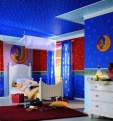 Acts positively. Despite the depressing effect on the nervous system, the negative effect on the pulse, it relieves muscle tension and dulls pain. However, it happens that being in a room dominated by blue, there is a feeling of fatigue and depression. In the children's room, the presence of blue in small quantities is acceptable (for example, pajamas, a child's bathrobe, a border on a blanket).
Acts positively. Despite the depressing effect on the nervous system, the negative effect on the pulse, it relieves muscle tension and dulls pain. However, it happens that being in a room dominated by blue, there is a feeling of fatigue and depression. In the children's room, the presence of blue in small quantities is acceptable (for example, pajamas, a child's bathrobe, a border on a blanket).

